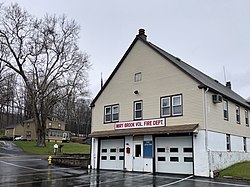Miry Brook, Connecticut | |
|---|---|
Unincorporated | |
 Miry Brook Volunteer Fire Department in 2022 | |
| Coordinates: 41°21′59.34″N73°28′56.44″W / 41.3664833°N 73.4823444°W [1] | |
| Country | United States |
| U.S. state | Connecticut |
| County | Fairfield |
| Region | Western CT |
| City | Danbury |
Miry Brook is an unincorporated area in the City of Danbury in Fairfield County, Connecticut. [1] It is located in the western part of the city, bordering Mill Plain to the north and west at Lake Kenosia and the town of Ridgefield, Connecticut, to the southwest. The Danbury Airport is located in Miry Brook.






